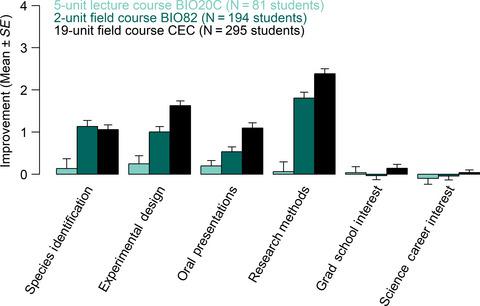当前位置:
X-MOL 学术
›
Ecol. Evol.
›
论文详情
Our official English website, www.x-mol.net, welcomes your
feedback! (Note: you will need to create a separate account there.)
Field courses narrow demographic achievement gaps in ecology and evolutionary biology.
Ecology and Evolution ( IF 2.3 ) Pub Date : 2020-05-08 , DOI: 10.1002/ece3.6300 Roxanne S Beltran 1 , Erin Marnocha 2 , Alexandra Race 3 , Donald A Croll 1 , Gage H Dayton 4 , Erika S Zavaleta 1
Ecology and Evolution ( IF 2.3 ) Pub Date : 2020-05-08 , DOI: 10.1002/ece3.6300 Roxanne S Beltran 1 , Erin Marnocha 2 , Alexandra Race 3 , Donald A Croll 1 , Gage H Dayton 4 , Erika S Zavaleta 1
Affiliation

|
Disparities remain in the representation of marginalized students in STEM. Classroom‐based experiential learning opportunities can increase student confidence and academic success; however, the effectiveness of extending learning to outdoor settings is unknown. Our objectives were to examine (a) demographic gaps in ecology and evolutionary biology (EEB) major completion, college graduation, and GPAs for students who did and did not enroll in field courses, (b) whether under‐represented demographic groups were less likely to enroll in field courses, and (c) whether under‐represented demographic groups were more likely to feel increased competency in science‐related tasks (hereafter, self‐efficacy) after participating in field courses. We compared the relationships among academic success measures and demographic data (race/ethnicity, socioeconomic status, first‐generation, and gender) for UC Santa Cruz undergraduate students admitted between 2008 and 2019 who participated in field courses (N = 941 students) and who did not (N = 28,215 students). Additionally, we administered longitudinal surveys to evaluate self‐efficacy gains during field‐based versus classroom‐based courses (N = 570 students). We found no differences in the proportion of students matriculating at the university as undecided, proposed EEB, or proposed other majors across demographic groups. However, five years later, under‐represented students were significantly less likely to graduate with EEB degrees, indicating retention rather than recruitment drives disparities in representation. This retention gap is partly due to a lower rate of college completion and partly through attrition to other majors. Although under‐represented students were less likely to enroll in field courses, field courses were associated with higher self‐efficacy gains, higher college graduation rates, higher EEB major retention, and higher GPAs at graduation. All demographic groups experienced significant increases in self‐efficacy during field‐based but not lecture‐based courses. Together, our findings suggest that increasing the number of field courses and actively facilitating access to students from under‐represented groups can be a powerful tool for increasing STEM diversity.
中文翻译:

实地课程缩小了生态学和进化生物学方面的人口成就差距。
边缘化学生在 STEM 中的代表性仍然存在差异。基于课堂的体验式学习机会可以增强学生的信心和学业成功;然而,将学习扩展到户外环境的有效性尚不清楚。我们的目标是检查(a)参加和未参加实地课程的学生在生态学和进化生物学(EEB)专业完成、大学毕业和 GPA 方面的人口差距,(b)代表性不足的人口群体的可能性是否较小参加实地课程,以及(c)代表性不足的人口群体在参加实地课程后是否更有可能感受到科学相关任务(以下称为自我效能)能力的提高。我们比较了 2008 年至 2019 年间参加实地课程( N = 941 名学生)和参加实地课程的加州大学圣克鲁斯分校本科生的学业成功指标和人口统计数据(种族/民族、社会经济地位、第一代和性别)之间的关系。没有( N = 28,215 名学生)。此外,我们还进行了纵向调查,以评估现场课程与课堂课程期间的自我效能感提升( N = 570 名学生)。我们发现,在不同人口群体中,未决定、拟选 EEB 或拟选其他专业的学生比例没有差异。然而,五年后,代表性不足的学生获得 EEB 学位的可能性显着降低,这表明是保留而不是招聘导致了代表性差异。这种保留差距的部分原因是大学毕业率较低,部分原因是其他专业的人员流失。 尽管代表性不足的学生参加实地课程的可能性较小,但实地课程与更高的自我效能感、更高的大学毕业率、更高的 EEB 专业保留率和更高的毕业 GPA 相关。所有人口群体在实地课程而非讲座课程中的自我效能感均显着提高。总之,我们的研究结果表明,增加实地课程的数量并积极促进来自代表性不足群体的学生的入学机会可以成为增加 STEM 多样性的有力工具。
更新日期:2020-06-26
中文翻译:

实地课程缩小了生态学和进化生物学方面的人口成就差距。
边缘化学生在 STEM 中的代表性仍然存在差异。基于课堂的体验式学习机会可以增强学生的信心和学业成功;然而,将学习扩展到户外环境的有效性尚不清楚。我们的目标是检查(a)参加和未参加实地课程的学生在生态学和进化生物学(EEB)专业完成、大学毕业和 GPA 方面的人口差距,(b)代表性不足的人口群体的可能性是否较小参加实地课程,以及(c)代表性不足的人口群体在参加实地课程后是否更有可能感受到科学相关任务(以下称为自我效能)能力的提高。我们比较了 2008 年至 2019 年间参加实地课程( N = 941 名学生)和参加实地课程的加州大学圣克鲁斯分校本科生的学业成功指标和人口统计数据(种族/民族、社会经济地位、第一代和性别)之间的关系。没有( N = 28,215 名学生)。此外,我们还进行了纵向调查,以评估现场课程与课堂课程期间的自我效能感提升( N = 570 名学生)。我们发现,在不同人口群体中,未决定、拟选 EEB 或拟选其他专业的学生比例没有差异。然而,五年后,代表性不足的学生获得 EEB 学位的可能性显着降低,这表明是保留而不是招聘导致了代表性差异。这种保留差距的部分原因是大学毕业率较低,部分原因是其他专业的人员流失。 尽管代表性不足的学生参加实地课程的可能性较小,但实地课程与更高的自我效能感、更高的大学毕业率、更高的 EEB 专业保留率和更高的毕业 GPA 相关。所有人口群体在实地课程而非讲座课程中的自我效能感均显着提高。总之,我们的研究结果表明,增加实地课程的数量并积极促进来自代表性不足群体的学生的入学机会可以成为增加 STEM 多样性的有力工具。











































 京公网安备 11010802027423号
京公网安备 11010802027423号